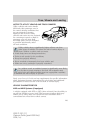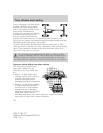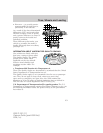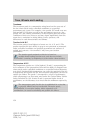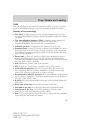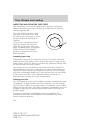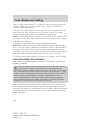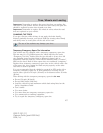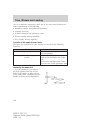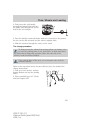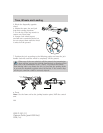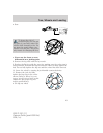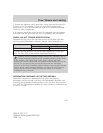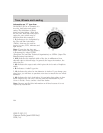
Important: Remember to replace the spare tire when you replace the
road tires on your vehicle. Even if it has never been used, the spare tire
should be replaced because tires degrade over time.
Important: Remember to replace the wheel air valves when the road
tires are replaced on your vehicle.
CHANGING THE TIRES
If you get a flat tire while driving, do not apply the brake heavily.
Instead, gradually decrease your speed. Hold the steering wheel firmly
and slowly move to a safe place on the side of the road.
The use of tire sealants may damage your tires.
Temporary Emergency Spare Tire Information
Your vehicle may be equipped with a temporary emergency spare tire.
This tire may be a T-type/mini-spare tire which will have the words
“Temporary Use Only” molded into the tire sidewall or it may be a full
size dissimilar spare tire/wheel that is different in brand, size or
appearance from the road tire, which will be identified with a “Caution”
label on the wheel. Both of these spare tires are considered “temporary”.
Replace these temporary emergency spare tires on the vehicle with a tire
of the same size, speed rating and load carrying capacity as the other
road tires as soon as possible.
It is not recommended that the vehicle be operated in 4WD modes with a
temporary emergency spare tire. If 4WD operation is necessary, do not
operate above speeds of 10 mph (16 km/h) or for distances above 50 miles
(80 km).
When driving with the temporary emergency spare tire do not:
• Exceed 50 mph (80 km/h)
• Exceed 2000 miles (3200 km)
• Load the vehicle beyond maximum vehicle load rating listed on the
Safety Compliance Label
• Tow a trailer
• Use snow chains
• Use more than one temporary emergency spare tire
• Use commercial car washing equipment
• Try to repair the temporary emergency spare tire
2005 F-150 (f12)
Owners Guide (post-2002-fmt)
USA (fus)
Tires, Wheels and Loading
157



